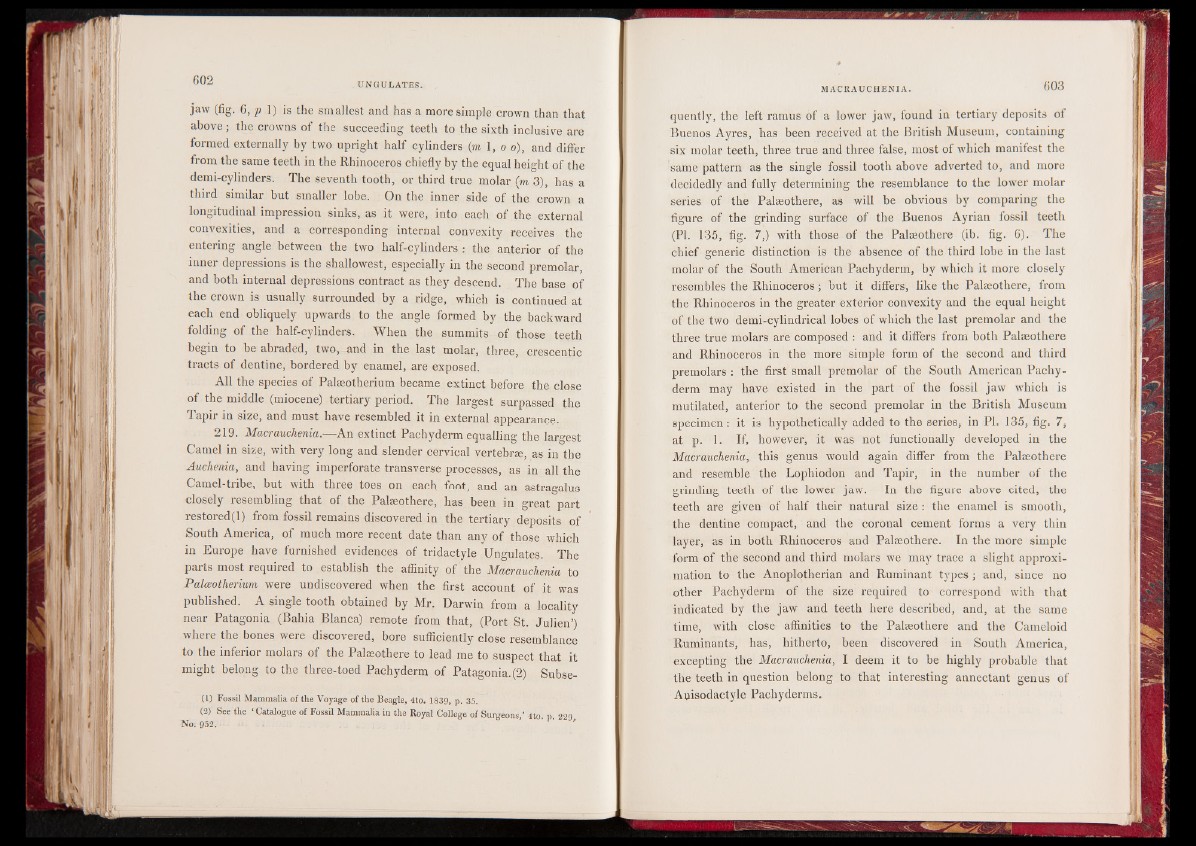
jaw (fig. 6, p 1) is the smallest and has a more simple crown than that
above; the crowns of the succeeding teeth to the sixth inclusive are
formed externally by two upright half cylinders (m 1, o o), and differ
from the same teeth in the Rhinoceros chiefly by the equal height of the
demi-cylinders. The seventh tooth, or third true molar (m 3), has a
third similar but smaller lobe. On the inner side of the crown a
longitudinal impression sinks, as it were, into each of the external
convexities, and a corresponding internal convexity receives the
entering angle between the two half-cylinders : the anterior of the
inner depressions is the shallowest, especially in the second premolar,
and both internal depressions contract as they descend. The base of
the crown is usually surrounded by a ridge, which is continued at
each end obliquely upwards to the angle formed by the backward
folding of the half-cylinders. When the summits of those teeth
begin to be abraded, two, and in the last molar, three, crescentic
tracts of dentine, bordered by enamel, are exposed.
All the species of Palseotherium became extinct before the close
of the middle (miocene) tertiary period. The largest surpassed the
Tapir in size, and must have resembled it in external appearance.
219. Macrauchenia.—An extinct Pachyderm equalling the largest
Camel in size, with very long and slender cervical vertebra, as in the
Auchenia, and having imperforate transverse processes, as in all the
Camel-tribe, but with three toes on each foot, and an astragalus
closely resembling that of the Palseothere, has been in great part
restored(l) from fossil remains discovered in the tertiary deposits of
South America, of much more recent date than any of those which
in Europe have furnished evidences of tridactyle Ungulates. The
parts most required to establish the affinity of the Macrauchenia to
Palaotherium were undiscovered when the first account of it was
published. A single tooth obtained by Mr. Darwin from a locality
near Patagonia (Bahia Blanca) remote from that, (Port St. Julien’)
where the bones were discovered, bore sufficiently close resemblance
to the inferior molars of the Palseothere to lead me to suspect that it
might belong to the three-toed Pachyderm of Patagonia.(2) Subse-
(1) Fossil Mammalia of the Voyage of the Beagle, 4to. 1839, p. 35.
(2) See the ‘ Catalogue of Fossil Mammalia in the Royal College of Surgeons,’ 4to. p. 229
No: 952.
quently, the left ramus of a lower jaw, found in tertiary deposits of
Buenos Ayres, has been received at the British Museum, containing
six molar teeth, three true and three false, most of which manifest the
same pattern as the single fossil tooth above adverted to, and more
decidedly and fully determining the resemblance to the lower molar
series of the Palseothere, as will be obvious by comparing the
figure of the grinding surface of the Buenos Ayrian fossil teeth
(PI. 135, fig. 7,) with those of the Palseothere (ib. fig. 6). The
chief generic distinction is the absence of the third lobe in the last
molar of the South American Pachyderm, by which it more closely
resembles the Rhinoceros; but it differs, like the Palseothere, from
the Rhinoceros in the greater exterior convexity and the equal height
of the two demi-cylindrical lobes of which the last premolar and the
three true molars are composed : and it differs from both Palseothere
and Rhinoceros in the more simple form of the second and third
premolars : the first small premolar of the South American Pachyderm
may have existed in the part of the fossil jaw which is
mutilated, anterior to the second premolar in the British Museum
specimen: it is hypothetically added to the series, in PI. 135, fig. 7,
at p. 1. If, however, it was not functionally developed in the
Macrauchenia, this genus would again differ from the Palseothere
and resemble the Lophiodon and Tapir, in the number of the
grinding teeth of the lower jaw. In the figure above cited, the
teeth are given of half their natural size : the enamel is smooth,
the dentine compact, and the coronal cement forms a very thin
layer, as in both Rhinoceros and Palseothere. In the more simple
form of the second and third molars we may trace a slight approximation
to the Anoplotherian and Ruminant types; and, since no
other Pachyderm of the size required to correspond with that
indicated by the jaw and teeth here described, and, at the same
time, with close affinities to the Palseothere and the Cameloid
Ruminants, has, hitherto, been discovered in South America,
excepting the Macrauchenia, I deem it to be highly probable that
the teeth in question belong to that interesting annectant genus of
Auisodactyle Pachyderms.